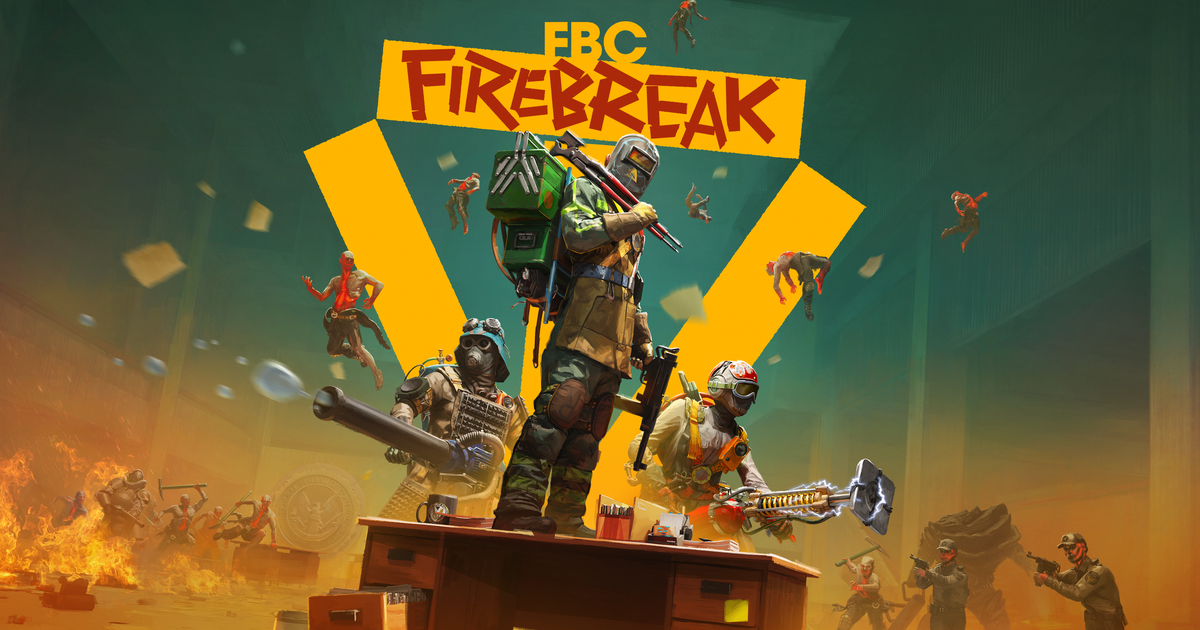Remedy’s Control spin-off FBC: Firebreak has only come together at the last minute – and somehow feels better for it

Anssi Hyytiäinen, Remedy’s lead designer on FBC: Firebreak, and studio veteran of more than 25 years, is “one of those really dangerous designers”. This is how his colleague, the game’s director Mike Kayatta, puts it to me in a conversation at Remedy’s predictably stylish HQ in Espoo, on the quiet, grey outskirts of Finland’s capital Helsinki. Kayatta means it as a compliment, although with maybe just a tinge of truth to it as well. He’s dangerous because, as Kayatta puts it, he’s one of the rare few designers who can “make his ideas manifest faster than he can tell you what it is.”
An example, per Kayatta: “Anssi will be like, Okay, what if we had this guidance drone that helped players?” and before Kaytatta can respond with an “I’m not sure about that,” it’s already in the game – “No, no, I’ve already built it, it’s a gigantic inflatable duck and it floats around and– woah woah woah!”
It all sounds a bit dysfunctional at first, as far as game development practices go. But then you play FBC: Firebreak and realise, actually, it might also be kind of brilliant. In talking to Kayatta for instance, as well as Hyytiäinen himself, I also realised this is emblematic of FBC: Firebreak’s development as a whole. This is a game that’s truly come together only now, in the final few months leading up to its mid-June launch. They both argue that’s part of making these kinds of games, the kinds that come with a heavy reliance on systemic design and cause and effect. They argue that the controlled chaos of development is essential, somehow, to FBC: Firebreak’s nature as an inherently, intentionally chaotic kind of game. Having played it for a couple of hours, I think that’s at least partially true. FBC: Firebreak is nothing if not chaotic.
Watch on YouTube
The premise with Firebreak is that you’re one of a team of three, slightly haphazard backroom problem-solvers called Firebreakers, dropped into a variety of multi-stage scenarios where an enemy force known as the Hiss (basically: Control-themed zombies) have overrun some deep corner of the Federal Bureau of Control building and stirred up some trouble. This premise itself is also a perfect example of Firebreak’s on-the-move track-laying.
The original kernel of an idea that became FBC: Firebreak arrived with Remedy’s initial decision to become a “multi project” studio, Kayatta explains (also a factor in why Remedy remains stout in its belief that Firebreak can avoid the usual live-service traps of launching today). The studio’s creative director, Mikael Kasurinen, had decided in that moment that it’d be a good idea to test out a “collective journey” for the Control universe – as in, a multiplayer one alongside the single-player. This led to some little prototypes, and the confirmation it would be made in the same North Light engine as Control – “none of that ended up being Firebreak,” Kayatta explains, “but also, it’s an interactive medium, so like, it is Firebreak.” Then Kayatta was brought onto the team, once a lot of multiplayer tech had been built in the engine, and it was decided that the team needed to get moving right away into active development.

“For me it was about finding the player fantasy, which was quite difficult,” Kayatta explains, “because we didn’t want to make a thousand Jesses, because that just makes Jesse seem lame. But I didn’t want to make a bunch of weak Jesses because that also feels like you’re doing a service to the narrative, but not the player. And then it was like: what if we came in from totally the opposite direction?” That, in the end, became the concept of Firebreakers: “completely normal, everyday people,” as Kayatta puts it, who then still need to feel heroic.
“That’s kind of where Firebreak came from – so it’s like a framework, and then it turned into a fantasy, and then all of the design, and then the idea of systems and how these things work, obviously all of that just spills right out of that player fantasy, once you have that in place.”


Those systems Kayatta is speaking of are particularly important for FBC: Firebreak. This might not have really carried through yet – it certainly hadn’t to me, before giving it a whirl myself – but Firebreak is aiming to be a systemic game, as in one with a sense of cause and effect, a bit of basic physics, some neat little interactions. In practice, this takes a little bit of time to winkle out.
The basic setup is a good place to start. There are three classes in FBC: Firebreak, referred to here as Crisis Kits: the jump kit, fix kit, and splash kit, each functioning as both a secondary weapon and a kind of practical tool to be used for completing your overall objectives. Weapons and grenades are freely interchangeable, once you unlock them with resources earned from your exploits, as are visual customisations, so the kits themselves are really the crux of things.
Here’s an example of how they might work together: in one level – or job – known as Hot Fix, you need to repair fans of the Oldest House’s infamous furnace before the whole place overheats. Some repairs require the jump kit, which uses jolts of electricity for both damage and electrical repairs. Others require the fix kit, which gives its Firebreaker a wrench with which to whack enemies in melee and repair other kinds of faults.



The splash kit, which lets you send large blobs of water (or many small blobs of water) at enemies to stagger them a little, doesn’t repair anything, but splashing enemies can prime them for a wider, chained jolt of higher damage electricity. Or, you can splash your fix kit user as they climb inside the searing hot fan to repair it at the source, keeping them cool and preventing them from catching fire. (Or, if like me you find it particularly annoying that they keep running off on their own away from the group, you can let them burn for a bit to teach them a little lesson, and then spray them once they get the point.)
All this is very much just the foundation, which spirals outwards into subtle complexities and little-known interactions, and combines with a deliberately calibrated finickiness to some of Firebreak’s smaller mechanics. Healing, for instance, is done by taking a shower, while ammo is primarily gained from a kind of tool station full of nuts and bolts. On most difficulties the two of these are located right by the elevator where you enter the level, and at the beginning of each subsequent stage, but sometimes they’ll require repairing first. Sometimes the shower will also have a broken heater which needs fixing too, less you end up with a cold shower that applies the cooling effect and slows you down.

Another nice touch: anyone can actually fix the broken fans on Hot Fix, regardless of their chosen kit, but without the right one you’ll need to follow a hectic minigame of mashing in two buttons in the right sequence for a long time, while your allies offer you some cover. It’s these purposeful trip hazards, the ones which lead to mishaps, rituals, or total disasters out in real multiplayer practice that give these kinds of games their charm.
Hyytiäinen has more examples – ceiling sprinklers can be shot at to set them off, dousing anyone or thing beneath them in water. A personal favourite of his is the addition of fast-moving air as a means of extinguishing fires. Or more specifically: if you’re on fire and hop on one of the handful of ziplines dotted around maps like that of Hot Fix, moving along it quickly enough will put that fire out. The downside of course being that you’re now on the other side of the map. Thomas Puha, Remedy’s PR director, who sat in on our interview and reckons he’s played thousands of hours of Firebreak, didn’t even know that was a possibility. There’s also one big one I’ve neglected to mention, and personally love, in friendly fire.
“Friendly fire is a good example of a very controversial design idea,” Hyytiäinen tells me, “because people have different contexts [from] where they think about it. We would have a lot of people in the team, as soon as that’s brought up, like: there’s going to be friendly fire?! What? It’s super hardcore – they think of military shooters, super realistic [games], immediately.” As soon as you have friendly fire, he explains, “you have to have team lives – if you have the chance of offing your friend, it needs to be fast for them to come back in, so it’s not really that painful, whereas if it was game over, now we’re in military shooter land.”


If friendly fire, panicked keypad-mashing, and cause and effect-based mowing down of enemy hordes sounds familiar to you, chances are you’ve also played Helldivers 2. The wildly popular co-op shooter from fellow Nordic studio Arrowhead has become a specific point of inspiration for Remedy with Firebreak (and one that drives home how relatively recently this has all started to pull together, given it only came out in February of last year).
It’s also another sign of Hyytiäinen’s notable impact on the game. Hyytiäinen only joined the Firebreak team – still only about 50 developers strong – around a year ago himself. Kayatta’s joking about his “dangerous” nature notwithstanding, Hyytiäinen’s impact sounds as though it’s been profound. He’s worked on every Remedy game since 1999, and arrives here as a kind of closer, taking the smart, yet still disparate ideas and moulding them into cohesive shape. “The vision, in broad terms, was similar to what it is now,” he says, referring to its systemic goals, “but that was kind of the problem – that the team composition was such that people weren’t maybe that used to thinking along those lines.”
Where Hyytiäinen was able to help, he says, was in “actually realising that vision.” In his words, systemic games in particular require “all the parts functioning together until it all starts to work – kind of like building an engine when you’re missing a piston; nothing works at all.” Much of that has involved simply reassuring the team that it’ll come together further down the line, a point which both Hyytiäinen and Kayatta agree on.
For Hyytiäinen it’s been about having “the wherewithal to actually put it through while people might be a bit like, I’m not sure if this is going to work out.” For Kayatta, it’s been a case of keeping the team on board with the broader vision, even as the finer details have had to change over time. “Having to say,” as he put it, “Okay, I know I just completely convinced you of this. Now it’s 10 percent different, and don’t forget everything, but forget that. That stuff gets really difficult, unless you have an extremely methodical, organised production from day one, which I’m convinced is an absolute myth for any game production. I don’t think there’s any actual, fully academic, solvable way of doing this – maybe Ubisoft or something has cracked it.”

Now, Remedy is at a point where some ideas, Hyytiäinen explains, can be implemented as quickly as in an afternoon, thanks to all the underlying work on the game’s systems being in place. It’s this kind of rapid-fire momentum that you can start to feel when you play it. At first FBC: Firebreak feels like a tentative take on the old Left4Dead formula. You fix your shower and you run off to do your little jobs, repairing a big fan, gathering weird, radioactive eggs, or zapping hundreds of scattered post-its, you mow down a couple of small clumps of not-zombies and you exfil back at the elevator.
But then you progress a little further, upping the clearance level – a kind of difficulty modifier that increases rewards – and work your way a little deeper into the bowels of the Oldest House, or towards a final, bright yellow boss. As the difficulty scales, and the stakes with them, those little mishaps and interactions start to matter. If you press the lift’s door button twice, as you might easily imagine yourself doing in a rush, huge waves of enemy heavies barreling down on you, those doors will start to open – and then close again. If you soak your pals as well as that onrushing horde and then said pal dutifully starts zapping away, you might find your whole team goes up in smoke as well – as they do when hit with your grenades, or your supers, or just your panicked shotgun fire.
This all stacks quite wonderfully, into a frantic, electrifying run-based shooter, with difficulties feeling like gambles – a wager of your crew’s time, against the difficulty and potential reward – and advanced weapons and kits, such as my glorified water pistol temporarily turning into a searing flamethrower, equally adept at searing said crew, all adding to it. Its potential is up there with the games other Remedy staff reference in casual chit-chat around the studio’s corridors, from Helldivers 2, yes, to Darktide, Payday, Deep Rock Galactic or even Overcooked, a co-op staple Kayatta is particularly keen on. (I’m told Smash Bros. remains the favourite on the office TV, though that one’s a bit more of a stretch for me to pull in here).
It might be coming together somewhat at the last, but again, perhaps that’s exactly the way these kinds of games need to work. And it’s certainly apt, given the genre. “We’re not going to say it’s perfect,” Hyytiäinen says, “there’s a couple of knobs I have to turn in there, in reality. But it’s systemic enough that it’s actually possible, within an afternoon, to throw in anything.” There’s still a good few more afternoons left until FBC: Firebreak’s launch, of course. So look out for inflatable duck-shaped drones.
This article is based on a press event at Remedy’s headquarters, for which it assisted with travel and accommodation.



